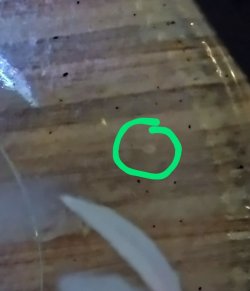Albino & Peppered Cory's spawning! Up til now it was just the peppered, but this morning I saw 1 of each with eggs between her fins. I also have 1 albino that hasn't grown at all since I bought them, and I have watched it eating, so I suspected the group weren't as healthy as the peppered.
I have been testing various forum methods to try and save some from my greedy Bristlenose, (mainly because I worry about her vegetarian gut, but my friend also said he would like a set) I have had some success, but I haven't yet pinned down which method it was that worked! I have tried 2 Types of breeder box (They either hatched and escaped, or were eaten by pleco because I have caught her climbing in & out), putting the adults in a separate tank (They seemed to stop spawning), and just covering the eggs in situ, with the divider from breeder & algae magnet, which allowed the eggs to hatch, but straight into a busy albeit peaceful community.
I woke up this morning to the biggest batch of eggs yet, so decided to run an experiment on which conditions they like best, because they scuppered my previous plan, by laying all of the eggs on the magnet and wrong side of the divider! After I collected them, 10mins later I looked again, and there were more!
I was just wondering if anyone could offer me their opinion on where to improve, because I have been collecting eggs now for a couple of months, and I have only grown 2 fry, there may be more hiding in both the community & nursery tank because I didn't actually see these ones until they reached at least 1cm long.
Listed methods photo's:
1)I have the ones on the divider in the floating breeder under main LED light, in the same corner they always lay eggs due to flow from canister with a net round it to monitor results/ give them a chance to mature a little before they join the rest.
2) I have a cookie jar, moss ball and baby bubbler in cupboard under tank for full darkness.
3)I put the algae magnet in the nursery biorb with no LED just natural light, plant's are suffering because I keep turning it off though (before anyone points it out, I do know how hideous biorb's can be but unfortunately the 80L I usually use as a quarantine/nursery sprung a small leak) it has a thriving well cycled bacteria colony, sponge filter and air stone and is maintaining the same water conditions as main tank, other than temperature as I turned the heater off (sitting at 21C, as someone on another forum pointed out the Cory fry like similar water/air temp for the first breath)
Any Recommendations on Fry/Shrimp safe fertilisers would be most welcome as well, I have a growing hair algae problem, I've been using shrimp safe root ball's & half dosing API Leafzone, with added CO2 but the Rotala (red orange and pink) are struggling to colour up and I fear succumbing to the algae.








I have been testing various forum methods to try and save some from my greedy Bristlenose, (mainly because I worry about her vegetarian gut, but my friend also said he would like a set) I have had some success, but I haven't yet pinned down which method it was that worked! I have tried 2 Types of breeder box (They either hatched and escaped, or were eaten by pleco because I have caught her climbing in & out), putting the adults in a separate tank (They seemed to stop spawning), and just covering the eggs in situ, with the divider from breeder & algae magnet, which allowed the eggs to hatch, but straight into a busy albeit peaceful community.
I woke up this morning to the biggest batch of eggs yet, so decided to run an experiment on which conditions they like best, because they scuppered my previous plan, by laying all of the eggs on the magnet and wrong side of the divider! After I collected them, 10mins later I looked again, and there were more!
I was just wondering if anyone could offer me their opinion on where to improve, because I have been collecting eggs now for a couple of months, and I have only grown 2 fry, there may be more hiding in both the community & nursery tank because I didn't actually see these ones until they reached at least 1cm long.
Listed methods photo's:
1)I have the ones on the divider in the floating breeder under main LED light, in the same corner they always lay eggs due to flow from canister with a net round it to monitor results/ give them a chance to mature a little before they join the rest.
2) I have a cookie jar, moss ball and baby bubbler in cupboard under tank for full darkness.
3)I put the algae magnet in the nursery biorb with no LED just natural light, plant's are suffering because I keep turning it off though (before anyone points it out, I do know how hideous biorb's can be but unfortunately the 80L I usually use as a quarantine/nursery sprung a small leak) it has a thriving well cycled bacteria colony, sponge filter and air stone and is maintaining the same water conditions as main tank, other than temperature as I turned the heater off (sitting at 21C, as someone on another forum pointed out the Cory fry like similar water/air temp for the first breath)
Any Recommendations on Fry/Shrimp safe fertilisers would be most welcome as well, I have a growing hair algae problem, I've been using shrimp safe root ball's & half dosing API Leafzone, with added CO2 but the Rotala (red orange and pink) are struggling to colour up and I fear succumbing to the algae.



